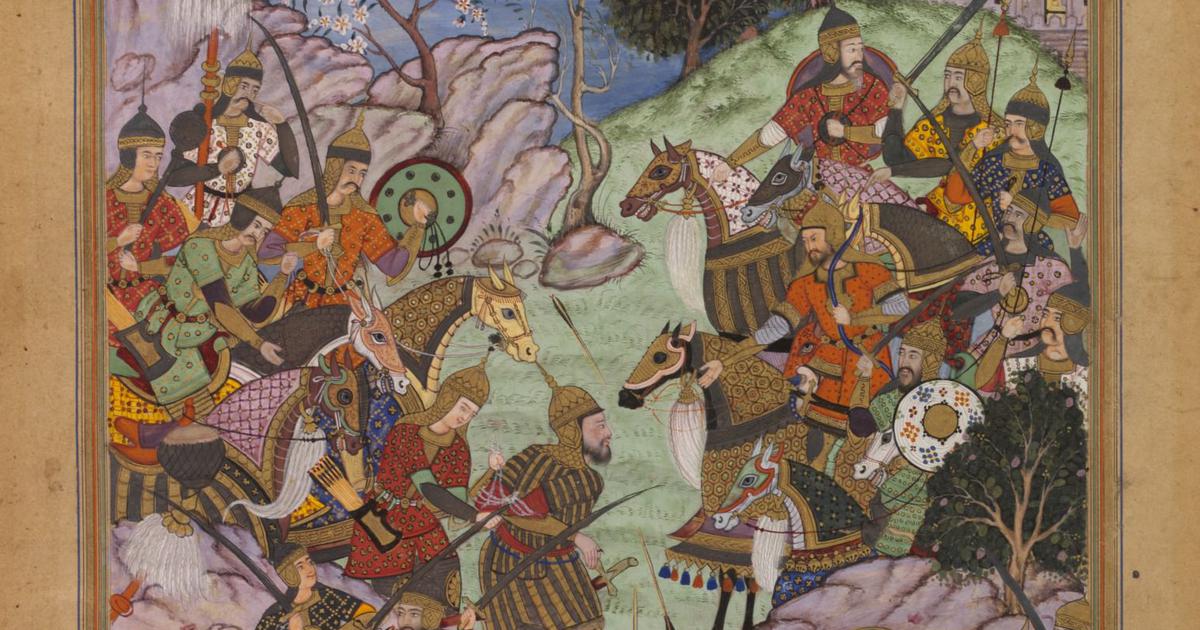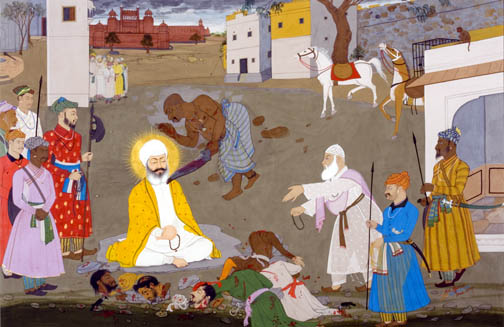During Aurangzeb’s long reign, the first notable execution was that of his brother Prince Dara Shikoh, who was accused of being influenced by Hinduism, though some sources claim it was done for political reasons. Aurangzeb had his ally Prince Murad Baksh arrested, tried, and executed for murder. Aurangzeb is accused of poisoning his nephew Sulaiman Shikoh, who is imprisoned.
Aurangzeb brutally executed the second Maratha Chhatrapati (King) Sambhaji in 1689. In a sham trial, he was found guilty of murder and violence, as well as atrocities committed by Marathas under his command against Muslims in Burhanpur and Bahadurpur in Berar.
Guru Tegh Bahadur, a Sikh leader, was arrested on Aurangzeb’s orders in 1675, found guilty of blasphemy by a Qadi’s court, and executed. Sambhaji was put on trial, found guilty of atrocities, and executed in 1689, according to Mughal accounts.
Empire
During a visit to Ladakh in 1663, Aurangzeb established direct control over the region, and loyal subjects like Deldan Namgyal agreed to pledge tribute and loyalty. Deldan Namgyal is also credited with building a Grand Mosque in Leh that he dedicated to Mughal rule.
Shaista Khan was named Subedar (Governor) of Bengal by Aurangzeb in 1664. Shaista Khan drove out Portuguese and Arakanese pirates from the region and reclaimed Chittagong from the Arakanese king, Sanda Thudhamma, in 1666. Throughout the Mughal era, Chittagong remained a vital port.
In 1685, Aurangzeb sent his son, Muhammad Azam Shah, with nearly 50,000 men to capture Bijapur Fort and defeat Sikandar Adil Shah (the ruler of Bijapur), who refused to be a vassal. The Mughals were unable to make any progress against Bijapur Fort, owing to superior cannon batteries on both sides. Outraged by the stalemate, Aurangzeb himself arrived on 4 September 1686 and led the Siege of Bijapur, which the Mughals won after eight days of fighting.
Abul Hasan Qutb Shah (the Qutbshahi ruler of Golconda), the only remaining ruler, refused to surrender. He and his troops fortified themselves at Golconda and fought valiantly to protect the Kollur Mine, which was at the time the world’s most productive diamond mine and a valuable economic asset. During the Siege of Golconda in 1687, Aurangzeb led his grand Mughal army against the Deccan Qutbshahi fortress.
The Qutbshahis had built massive fortifications on a granite hill over 400 feet high with an eight-mile-long wall enclosing the city over successive generations. Any war elephant attack could be repelled at Golconda’s main gates. Even though the Qutbshahis’ walls were impregnable, Aurangzeb and his infantry erected complex scaffolding that allowed them to scale the high walls at night. The Mughals faced many difficulties during the eight-month siege, including the death of their experienced commander Kilich Khan Bahadur. After capturing a gate, Aurangzeb and his forces were able to break through the fort’s walls, forcing Abul Hasan Qutb Shah to surrender peacefully.
Art and Culture
Aurangzeb was known for being more austere than his forefathers. He encouraged Islamic calligraphy because he was religious. During his reign, the Lahore Badshahi Masjid and the Bibi Ka Maqbara in Aurangabad were built for his wife Rabia-ud-Daurani.
Calligraphy
Parts of the manuscript Quran are thought to have been written by Aurangzeb himself. During his reign, the Mughal Emperor Aurangzeb is said to have patronized Islamic calligraphy, particularly that of Syed Ali Tabrizi.
Architecture
Aurangzeb, unlike his father, was uninterested in architecture. In the Red Fort complex in Delhi, Aurangzeb built the Moti Masjid (Pearl Mosque), a small marble mosque. In Lahore, he ordered the construction of the Badshahi Mosque. On Benares, he also built a mosque. In Srinagar, he built the largest mosque in Kashmir, which is still in use today. The sons of Aurangzeb built the Bibi Ka Maqbara structure in Aurangabad, which is now a historical monument, in memory of their mother. The Taj Mahal was the source of inspiration, as evidenced by its architecture.
Textiles
The Mughal Empire’s textile industry blossomed during the reign of Mughal Emperor Aurangzeb, and Francois Bernier, the Mughal Emperor’s French physician, was particularly impressed. Karkanahs, or workshops for artisans, flourished, according to Francois Bernier, by “employing hundreds of embroiderers, who were superintended by a master.” “Artisans manufacture silk, fine brocade, and other fine muslins, of which are made turbans, robes of gold flowers, and tunics worn by females, so delicately fine that they wear out in one night, and cost even more if they were well embroidered with fine needlework,” he continues.
Tribute
Aurangzeb amassed wealth from all over the Indian subcontinent and used it to build bases and fortifications across the country, particularly in the Carnatic, Deccan, Bengal, and Lahore.
The Ahom Campaign
While Aurangzeb and his brother Shah Shuja were fighting, Hindu rulers in Kuch Behar and Assam took advantage of the Mughal Empire‘s chaos and invaded imperial domains. They were not attacked for three years, but in 1660, the Viceroy of Bengal Mir Jumla II was ordered to reclaim the lost territories.
In November 1661, the Mughals set sail. They occupied and annexed Kuch Behar’s capital in a matter of weeks. The Mughal army began retaking their Assam territories, leaving a detachment to guard it. Mir Jumla II advanced on Garhgaon, the Ahom kingdom’s capital, and arrived on March 17, 1662. Raja Sutamla, the ruler, had fled before he arrived. 82 elephants, 300,000 rupees in cash, 1000 ships, and 173 rice stores were taken by the Mughals.
Mir Jumla II died of natural causes on his way back to Dacca in March 1663. After the rise of Chakradhwaj Singha, who refused to pay further indemnity to the Mughals, skirmishes between the Mughals and Ahoms continued, and the Mughals suffered great hardships during the wars that followed. Munnawar Khan rose to prominence and is credited with supplying food to vulnerable Mughal forces in the Mathurapur region. Despite the fact that the Mughals, led by Syed Firoz Khan the Faujdar at Guwahati, were defeated by two Ahom armies in 1667, they continued to hold and maintain a presence in their eastern territories even after the Battle of Saraighat in 1671.
The Battle of Saraighat was fought in 1671 on the Brahmaputra River at Saraighat, now in Guwahati, between the Mughal Empire (led by the Kachwaha king, Raja Ramsingh I) and the Ahom Kingdom (led by Lachit Borphukan). Despite being much weaker, the Ahom Army defeated the Mughal Army through brilliant use of the terrain, deft diplomatic maneuvering to buy time, guerrilla tactics, psychological warfare, military intelligence, and exploiting the Mughal forces’ sole weakness—their navy.
The Battle of Saraighat marked the end of the Mughals’ last major attempt to expand their empire into Assam. The Mughals briefly reclaimed Guwahati after a later Borphukan deserted it, but the Ahoms reclaimed it in the Battle of Itakhuli in 1682 and held it until the end of their reign.
Satnami Opposition
In May 1672, the Satnami sect, acting on the orders of an “old toothless woman” (according to Mughal accounts), staged a massive revolt in the Mughal Empire’s agricultural heartlands. The Satnamis shaved their heads and even their eyebrows and built temples in many parts of Northern India. 75 miles southwest of Delhi, they began a large-scale rebellion.
The Satnamis believed they were impervious to Mughal bullets and that they could reproduce in any area they entered. The Satnamis marched into Delhi and defeated small-scale Mughal infantry units.
Aurangzeb retaliated by assembling a Mughal army of 10,000 troops and artillery, as well as dispatching detachments of his personal Mughal imperial guards to complete various tasks. Aurangzeb wrote Islamic prayers, made amulets, and drew designs that would become Mughal Army emblems to boost Mughal morale. Punjab would suffer serious consequences as a result of this rebellion.
Opposition of Sikhs
Various insurgent groups of Sikhs engaged Mughal troops in increasingly bloody battles early in Aurangzeb’s reign. Guru Tegh Bahadur, the ninth Sikh Guru, was, like his predecessors, opposed to the conversion of the local population, believing it to be immoral. According to Sikh sources, Guru Tegh Bahadur took on Aurangzeb after being approached by Kashmiri Pandits to help them keep their faith and avoid forced religious conversions.
The emperor saw the Guru’s rising popularity as a threat to his rule and had him executed in 1670, which infuriated the Sikhs. In response, Guru Tegh Bahadur’s son and successor, Guru Gobind Singh, began militarising his followers in 1699, eight years before Aurangzeb’s death, with the founding of Khalsa. Guru Gobind Singh wrote the Zafarnamah letter in 1705, accusing Aurangzeb of cruelty and betrayal of Islam. He was distressed and remorseful as a result of the letter. The Sikh Confederacy and later the Sikh Empire were founded after Guru Gobind Singh founded Khalsa in 1699.
Pashtun Opposition
Soldiers under the orders of Mughal Governor Amir Khan allegedly molested women of the Pashtun tribes in modern-day Kunar Province of Afghanistan, triggering the Pashtun revolt in 1672 led by the warrior-poet Khushal Khan Khattak of Kabul. The soldiers were retaliated against by the Safi tribes. This attack sparked retaliation, resulting in a general revolt among most tribes. Amir Khan led a large Mughal army to the Khyber Pass in an attempt to reassert his authority, but the army was surrounded by tribesmen and routed, with only four men, including the Governor, escaping.
“Black is the Mughal’s heart towards all of us Pathans,” Khushal Khan Khattak said of Aurangzeb’s incursions into Pashtun areas. Aurangzeb used a scorched-earth strategy, sending troops to massacre, loot, and burn many villages. Aurangzeb then proceeded to use bribery to turn Pashtun tribes against one another in order to divert attention away from a unified Pashtun challenge to Mughal authority, leaving a lasting legacy of mistrust among the tribes.
Following that, the revolt spread, and the Mughals’ authority in the Pashtun belt was nearly destroyed. The Grand Trunk Road’s closure of the important Attock-Kabul trade route was particularly disastrous. The situation had deteriorated to the point where Aurangzeb camped at Attock to take command personally in 1674. The Mughals eventually split the rebels and partially suppressed the revolt by using diplomacy and bribery in addition to the force of arms, though they never managed to wield effective authority outside of the main trade route.
Death
Mughal victories in the south by 1689, when Golconda was conquered, had expanded the Mughal Empire to 4 million square kilometers, with a population of over 158 million people. However, this reign of terror was short-lived.
Unlike his forefathers, Aurangzeb believed that the royal treasury should be held in trust for the people of his empire. To supplement his income, he made caps and copied the Quran. In the Red Fort complex in Delhi, Aurangzeb built the Moti Masjid (Pearl Mosque), a small marble mosque. His constant warfare, particularly with the Marathas, brought his empire to the brink of bankruptcy, just as his predecessors’ wasteful personal spending and opulence had.
In many ways, Aurangzeb’s conquest of the Deccan, to which he devoted the final 26 years of his life, was a Pyrrhic victory, costing an estimated hundred thousand lives per year during its final decade of futile chess game warfare. The cost of gold and rupees is difficult to estimate accurately. Aurangzeb’s encampment, a city of tents 30 miles in circumference with 250 bazaars, 12 million camp followers, 50,000 camels, and 30,000 elephants, all of whom had to be fed, robbed the Deccan of all surplus grain and wealth.
Even when he was sick and dying, Aurangzeb made sure that the people knew he was still alive, because if they didn’t, another succession war would erupt. He died on February 20, 1707, at the age of 89, at his military camp in Bhingar, near Ahmednagar, having outlived many of his children. His simple open-air grave in Khuldabad reflects his unwavering commitment to his Islamic beliefs. It is located in the courtyard of the Sufi saint Shaikh Burhan-ud-din Gharib’s shrine, who was a disciple of Delhi’s Nizamuddin Auliya.



